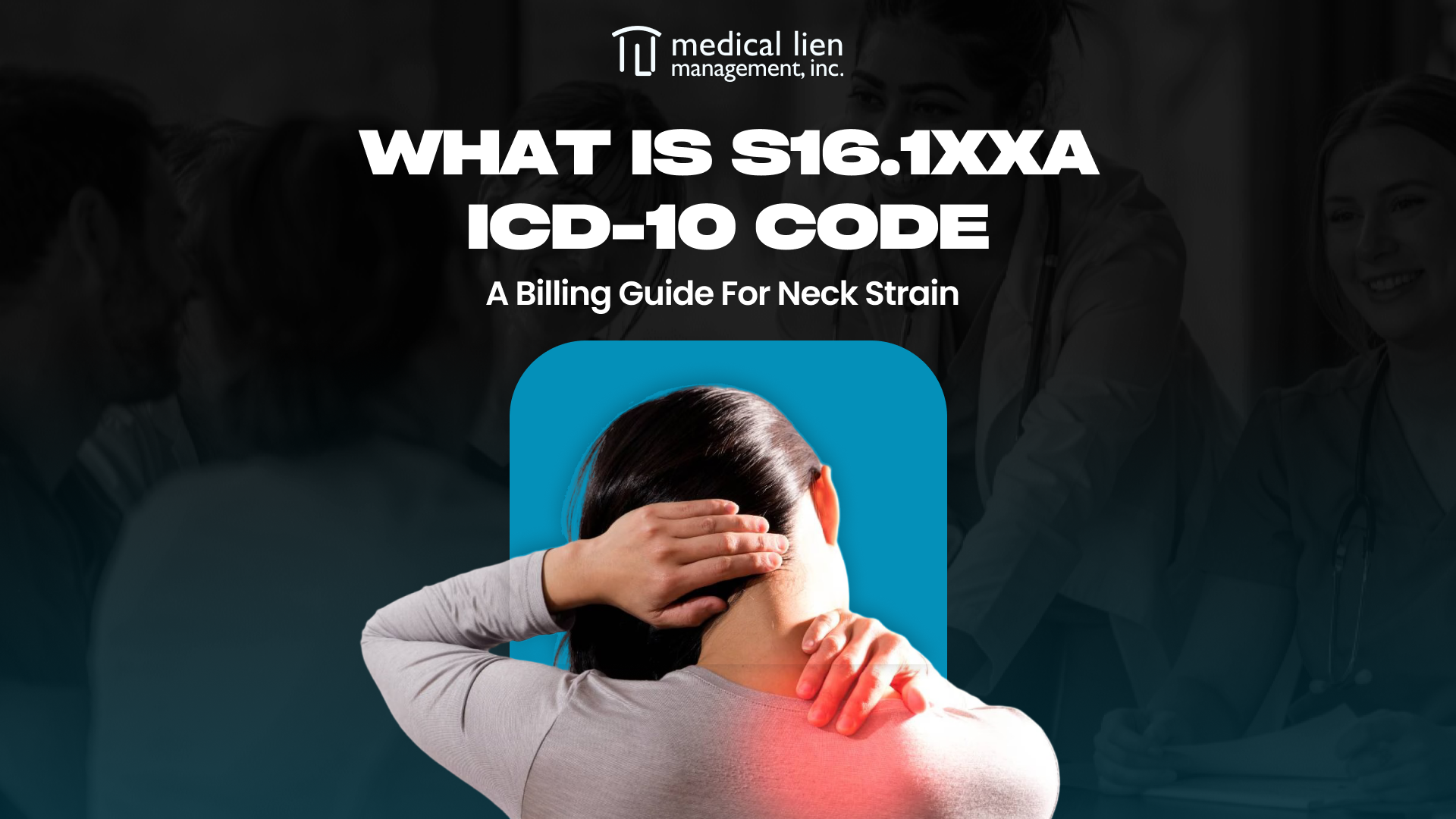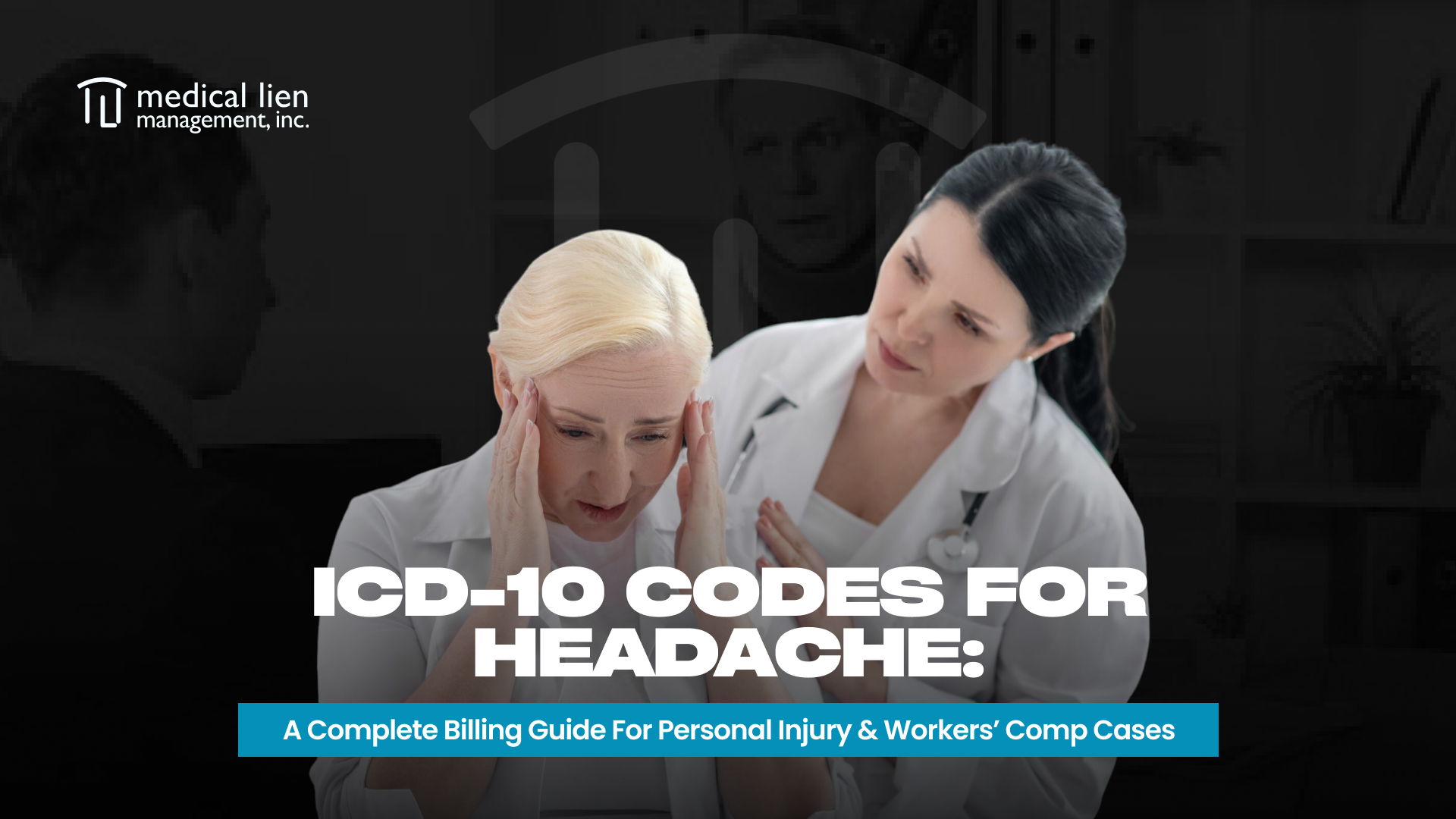If you treat patients with neck injuries, especially after auto accidents or falls, you’ve likely coded for a neck strain. But is your documentation strong enough to secure proper reimbursement?
Here’s the reality: S16.1XXA is one of the most commonly used yet frequently under-coded diagnosis codes in personal injury (PI) cases. When not used properly, it can lead to denials, reduced settlement value, and lost revenue.
In this billing guide, we’ll break down everything you need to know about ICD code S16.1XXA: what it means clinically, when to use it, how to pair it with the right CPT codes, and why it plays a crucial role in lien-based reimbursement strategies.
What is the S16.1XXA ICD-10-CM Diagnosis Code?
The S16.1XXA code is used to classify a strain involving the muscle, fascia, or tendon at the neck level, typically resulting from trauma such as a car accident, whiplash, or slip-and-fall.
Clinical Description
- ICD-10 Code: S16.1XXA
- Diagnosis: Strain of muscle, fascia, and tendon at neck level
- Encounter: Initial (designated by the “A” at the end of the code)
This code is typically used for first visits after a traumatic neck injury. It reflects acute damage to soft tissues and is often accompanied by symptoms such as pain, stiffness, reduced mobility, or headaches.
Code Classification
- Section: Injury, poisoning and certain other consequences of external causes (S00–T88)
- Chapter: Injury of neck (S10–S19)
- Subcategory: S16 – Injury of muscle and tendon at neck level
- Specific Code: S16.1 – Strain of muscle, fascia and tendon at neck level
Code Dependencies
- 7th Character Requirement: This code requires a 7th character, such as:
- A – Initial encounter
- D – Subsequent encounter
- S – Sequela
Without the proper 7th character, your claim will be rejected or denied.
When to Use ICD-10 Code S16.1XXA
Knowing when to use this code, and how to differentiate it from similar ones, is essential for accurate billing and case defensibility.
Common Etiologies (Causes of Injury)
S16.1XXA is typically appropriate for cases involving:
- Motor vehicle accidents (MVAs)
- Sports injuries
- Whiplash from rear-end collisions
- Workplace trauma
- Assault-related trauma
- Slip and falls with head or upper body impact
These injuries often result in overstretching or tearing of the neck’s soft tissue structures.
Differentiating S16.1XXA from Similar Codes
It’s important to avoid using general or non-specific codes when a more precise option like S16.1XXA is available. Here’s how it compares:
| Code | Description | When to Use |
| S13.4XXA | Sprain of cervical spine | For ligament-based injuries in the cervical spine |
| M54.2 | Cervicalgia (neck pain) | Use only if pain is present without a documented cause |
| S16.1XXA | Strain of muscle/fascia/tendon at neck | When soft tissue strain is confirmed after trauma |
Incorrect coding (e.g., using M54.2 instead of S16.1XXA) can lower the case value and invite scrutiny from payers and attorneys.
Is S16.1XXA a Billable Code?
Yes, S16.1XXA is a fully billable ICD-10 code, but only if documented properly.
Key billing requirements:
- Must include the 7th character to reflect encounter status
- Must be supported by provider notes and physical findings
- Should correlate with imaging, when applicable
- Must be paired with medically necessary CPT codes
CPT Codes Commonly Linked to S16.1XXA
Pairing S16.1XXA with the right CPT codes ensures your documentation aligns with services rendered and supports both medical necessity and lien defensibility.
Evaluation and Management (E/M) Codes
- 99202–99205 – New patient office visits
- 99212–99215 – Established patient office visits
These codes support your initial examination, clinical decision-making, and ongoing care.
Physical Medicine and Rehabilitation Codes
- 97110 – Therapeutic exercises to improve strength or range of motion
- 97112 – Neuromuscular re-education (especially helpful for whiplash rehab)
- 97140 – Manual therapy techniques (e.g., soft tissue mobilization)
- 97530 – Therapeutic activities for functional performance improvement
- 97035 – Ultrasound therapy for deep tissue healing
Other Relevant Procedures
- 20552 – Trigger point injection(s) for neck strain-related muscle spasms
- 95851 – Range of motion measurements for cervical spine
- 72040 – Cervical spine X-ray (for differential diagnosis)
Each of these CPT codes should align with your treatment plan and be backed by solid clinical notes.
Why S16.1XXA is a Critical Code for Personal Injury Liens
Beyond coding accuracy, S16.1XXA plays a vital role in determining how much you’re reimbursed in personal injury billing and liens. When a case involves a legal settlement, the value of the claim depends heavily on the severity and type of injury documented.
The Direct Link Between Diagnosis and Case Value
Attorneys and insurance adjusters review medical records to assess:
- The severity of injury
- The necessity of treatment
- The impact on daily function and pain level
A code like S16.1XXA carries more clinical weight than a vague diagnosis like “neck pain.” It quantifies tissue damage, substantiates the patient’s pain and suffering, and justifies the duration and intensity of treatment.
Protecting Your Revenue in PI Cases
If you under-code or use a less specific diagnosis, the lien value may be questioned. Over time, this results in:
- Reduced settlements
- Deep lien reductions
- Delayed payments
- Missed revenue opportunities
Proper use of S16.1XXA ensures your lien stands up to scrutiny and gets prioritized during settlement disbursement.
The Risk of Under-Coding
Using general codes (e.g., M54.2) can imply minimal injury. This opens the door for insurance adjusters to:
- Challenge the necessity of your care
- Argue for lower payouts
- Delay negotiations with attorneys
Being precise, and using S16.1XXA when clinically appropriate, makes your medical claim harder to dispute and easier to justify in court or mediation.
Navigating Denials and Underpayments for S16.1XXA
Even with accurate documentation and appropriate use of S16.1XXA, providers can still face claim denials or reduced reimbursements, especially in personal injury cases where third-party payers and attorneys scrutinize every detail.
Understanding the common issues and how to proactively address them can prevent revenue loss.
Common Reasons for Claim Denials
- Missing 7th Character
Without the “A” (initial encounter), your claim may be marked incomplete. S16.1XXA specifically requires this to be a billable code. - Insufficient Clinical Documentation
If the provider note doesn’t clearly identify a strain and its relationship to an accident, insurers may reclassify the injury as generic neck pain, reducing payout value. - Lack of Associated CPT Codes
Using S16.1XXA without linking appropriate services (e.g., evaluation, rehab, imaging) weakens the claim’s justification. - Payer Misinterpretation
Some payers may not recognize the value of this code in a PI context or may try to downgrade the injury to reduce their settlement liability.
How to Fight S16.1XXA Denials
Here’s how to build a solid case for reimbursement:
- Include Detailed Notes: Use SOAP format (Subjective, Objective, Assessment, Plan) and clearly describe the injury, accident, and clinical findings.
- Use Specific CPT Pairings: Match the diagnosis with E/M codes, therapeutic procedures, and diagnostics to demonstrate the necessity of treatment.
- Attach Imaging or Exam Findings: If X-rays or ROM studies were performed, include those to validate the strain diagnosis.
- Include Attorney or Settlement Details (in PI cases): Show how the injury ties to a third-party case. This makes it harder for payers to dispute the medical necessity.
- Submit a Second Review or Appeal: In California, providers can submit a Second Review within 90 days of receiving an Explanation of Review (EOR). If that’s denied, proceed to Independent Bill Review (IBR) within 30 days, including the filing fee.
Are You Being Underpaid for Neck Strain Claims?
If your lien payments on neck strain cases feel low, or if you’re routinely accepting reduced payouts, you’re not alone.
The Adversarial Nature of PI Billing
In personal injury cases, insurance adjusters are not neutral. Their role is to minimize the payout. They may question:
- The necessity of ongoing care
- The validity of a strain diagnosis
- The duration or frequency of visits
- Whether the injury impacted the patient’s daily life
Even attorneys may delay or de-prioritize medical lien collections in favor of their client’s portion of the settlement.
How Medical Lien Management Secures Your Full Reimbursement
At Medical Lien Management, we help providers avoid denials, reduce reductions, and get paid in full, especially on cases coded with S16.1XXA and similar diagnoses.
Here’s how we do it:
Expert Coding Review
Every claim is reviewed by certified medical coders to ensure accuracy and defensibility. We make sure ICD-10 codes, CPT pairings, and encounter details are aligned and compliant.
Fast, Accurate Jet Filing
Our proprietary Jet Filing system ensures claims are submitted quickly and correctly, reducing administrative errors and payer pushback.
Legal Coordination
We communicate directly with attorneys, helping them understand the medical necessity behind your diagnosis and the lien value. This increases the likelihood of full reimbursement.
Appeals & Litigation Support
If your claim is denied or reduced, MLM handles Second Reviews, IBRs, and even litigation coordination to defend your lien.
Detailed Case Tracking
You get visibility into every step of the process, from intake to settlement, so nothing slips through the cracks.
Conclusion
Accurately using and defending S16.1XXA is more than a coding issue, it’s an effective strategy to a streamlined healthcare revenue cycle.
In personal injury cases, the right diagnosis code:
- Substantiates injury severity
- Increases the potential settlement value
- Helps secure full reimbursement
- Reduces denial risks
Yet without detailed documentation, matching CPT codes, and expert follow-up, you risk being underpaid or not paid at all.





